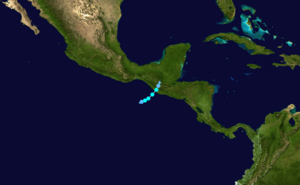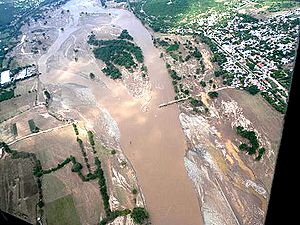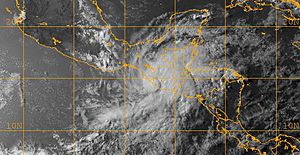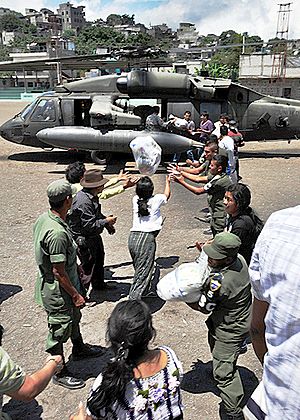Tropical Storm Agatha facts for kids

Tropical Storm Agatha near peak intensity off the coast of Guatemala on May 29.
|
|
| Meteorological history | |
|---|---|
| Formed | May 29, 2010 |
| Remnant low | May 31, 2010 |
| Dissipated | June 1, 2010 |
| Tropical storm | |
| 1-minute sustained (SSHWS/NWS) | |
| Highest winds | 45 mph (75 km/h) |
| Lowest pressure | 1001 mbar (hPa); 29.56 inHg |
| Overall effects | |
| Fatalities | 204 |
| Damage | $1.1 billion (2010 USD)(Fourth-costliest in the East Pacific on record) |
| Areas affected | Southwestern Mexico and Central America; especially Guatemala |
|
Part of the 2010 Pacific hurricane season |
|
Tropical Storm Agatha was a powerful but short-lived tropical storm. It caused widespread floods and was very deadly in Central America. It was the deadliest tropical cyclone in the eastern Pacific since Hurricane Pauline in 1997.
Agatha was the first storm of the 2010 Pacific hurricane season. It started from a stormy area called the Intertropical Convergence Zone. It became a tropical depression on May 29, then a tropical storm. Agatha reached its strongest winds of 45 mph (75 km/h). It made landfall (hit land) near the border of Guatemala and Mexico on May 29.
The storm brought heavy rain across Central America. This caused one death in Nicaragua. In Guatemala, 152 people died and 100 went missing due to landslides. Thirteen people also died in El Salvador. Agatha soon weakened and disappeared over Guatemala. By June 15, officials in Guatemala reported 165 deaths and 113 missing people.
In total, Agatha caused at least 204 deaths. It also caused about $1.1 billion in damage across Central America. Even with all this damage, the name "Agatha" was not retired. This means it was used again for a storm in 2016.
Contents
How Tropical Storm Agatha Formed and Moved
Tropical Storm Agatha began as a cluster of thunderstorms. This happened on May 24, off the west coast of Costa Rica. At that time, there was a low-pressure area, or "trough," in the region. This trough was connected to the Intertropical Convergence Zone, where many thunderstorms form.
The storm system moved slowly northwest. Conditions were good for it to grow into a tropical cyclone. On May 25, the thunderstorms became more organized. The National Hurricane Center (NHC) started watching it closely. They thought it might become a tropical depression.
The storm got more organized over the next few days. On May 29, the NHC officially named it Tropical Depression One-E. It was about 295 miles (475 km) west of San Salvador, El Salvador.
When it became a tropical cyclone, the ocean water was warm (30 °C or 86 °F). There was also little wind shear, which means winds did not blow in different directions at different heights. These conditions usually help storms get stronger. However, the mountains along the Central American coast limited how much it could grow.
The depression moved slowly northeast. It was circling around a high-pressure area, or "ridge," over northern South America. A few hours later, satellites saw that the storm had tropical storm-force winds. So, the NHC upgraded it to Tropical Storm Agatha.
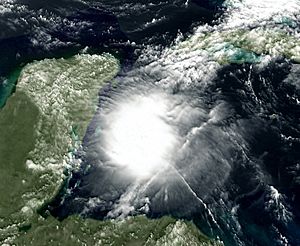
Agatha reached its strongest point with winds of 45 mph (75 km/h). Its lowest pressure was 1001 mbar. Within two hours, Agatha suddenly moved north. It made landfall at 22:30 UTC near Champerico, Guatemala.
After hitting land, Agatha continued to cause floods and landslides. However, it did not bring many strong winds ashore. The storm quickly weakened after moving inland. Its winds dropped to 25 mph (40 km/h) before it disappeared. On May 31, some thunderstorms from Agatha moved east of Belize, into the Atlantic Ocean. The NHC said these storm remnants had a low chance of forming into a new storm.
Getting Ready for Tropical Storm Agatha
When Tropical Depression One-E formed on May 29, the Government of Guatemala issued a tropical storm warning. This warning covered the entire Pacific coastline. Because the storm was so close to land, strong winds were expected to reach the coast quickly. This made it hard for people to prepare outside.
Also, the storm was moving very slowly. This meant it would bring huge amounts of rain, possibly more than 30 inches (760 mm) in some areas. This rain was expected to cause dangerous flash floods and landslides in Guatemala, El Salvador, and southeastern Mexico.
Once the storm became Tropical Storm Agatha, the NHC warned about storm surge and big waves. These were expected in areas south and east of where the storm would hit. By the morning of May 29, Guatemalan officials put all hospitals on high alert. They also declared a state of emergency. President Álvaro Colom started using some of the $85 million in emergency funds from the World Bank. After the storm moved inland and weakened, the tropical storm warnings for the coast were stopped.
In El Salvador and Nicaragua, emergency teams helped about 2,000 people move to safer places. This was because of the danger of flash flooding. El Salvador declared a yellow alert for the whole country. About 89% of the country was at risk from flooding. Around 52,000 police, rescue workers, and soldiers were ready to help.
Agatha's Impact on Central America
| Country | Deaths | Missing | Damage (USD) |
| El Salvador | 11 | 2 | $112 million |
| Guatemala | 174 | 13 | $982 million |
| Honduras | 18 | 0 | $18.5 million |
| Mexico | 0 | 0 | Minimal |
| Nicaragua | 1 | 0 | Minimal |
| Total | 204 | 15 | ~$1.1 billion |
Impact in Nicaragua
Even before it became a tropical depression, Agatha caused very heavy rain in Nicaragua. One person died after being swept away by a flooded river. Many homes and bridges were destroyed across the country. In Estelí Department, the Nicaraguan Air Force had to rescue 24 people who were stuck in their homes.
Impact in Guatemala
Two days before Agatha hit, the Pacaya volcano erupted on May 27. This volcano is about 25 miles (40 km) south of Guatemala City. The eruption killed one person and forced over 2,000 people to leave their homes. It also temporarily closed the main international airport. The heavy rain from Agatha could make things worse by causing mudflows called lahars. However, coffee farmers thought the rain helped by washing ash off their trees.
According to weather experts in Guatemala, at least 14 inches (360 mm) of rain had fallen by the evening of May 29. Several landslides blocked roads in southern Guatemala, making travel difficult. After the storm, a three-story building disappeared into a 30-meter (100-ft) wide sinkhole. This sinkhole was caused by Agatha's heavy rainfall.
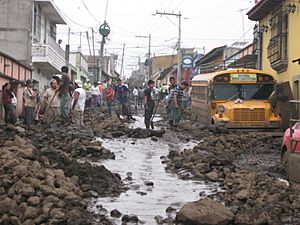
A mudslide from the Agua volcano killed 9 people and left 12 missing in San Miguel Escobar. In Almolonga, a mudslide caused by the storm destroyed a home and killed four people. In total, twelve people died in Guatemala, and another landslide left 11 people missing.
Officials in Guatemala declared a state of emergency on May 29 as conditions got worse. Many rivers were already very full and close to overflowing. Many homes were destroyed by widespread floods, and dozens of emergency rescues were needed.
By May 30, reports said that 15 people had died and 22 were missing in Guatemala. Early damage reports showed that at least 3,500 homes were damaged. A total of 112,000 people had to leave their homes. Also, at least 20,000 people lost their homes because of the storm. Some areas had the heaviest rainfall in over 60 years, measuring more than 36 inches (910 mm). This made Agatha the wettest tropical cyclone to ever hit the country, even more than Hurricane Mitch. By the next day, the number of deaths rose to 92, with 95 people injured.
In Guatemala City, a sinkhole 30 stories deep opened up. It killed 15 people and put 300 residents in danger. A three-story house, telephone poles, and a security guard were swallowed by the sinkhole. The sinkhole formed because sewage pipes were leaking, and the flooding from Agatha made the problem much worse.
Impact in Mexico
| Storm | Season | Damage (USD) | Ref. |
|---|---|---|---|
| Manuel | 2013 | $4.2 billion | |
| Iniki | 1992 | $3.1 billion | |
| Odile | 2014 | $1.25 billion | |
| Agatha | 2010 | $1.1 billion | |
| Willa | 2018 | $825 million | |
| Madeline | 1998 | $750 million | |
| Rosa | 1994 | $700 million | |
| Paul | 1982 | $520 million | |
| Octave | 1983 | $512.5 million |
In southern Mexico, Agatha brought strong winds and heavy rain. It also caused high waves, estimated to be between 2 and 4 meters (7 and 13 feet) high. At least 120 families were moved from southeastern Chiapas, near where the storm hit. A yellow alert was also declared for the state because a lot of flooding was expected.
Impact in Honduras
After moving over Guatemala and Mexico, the heavy rains from Agatha's leftover parts caused flash flooding and landslides in parts of Honduras. At least 45 homes were destroyed, and one person died in the country. On May 31, the presidents of El Salvador and Honduras declared a state of emergency for their countries.
Impact in El Salvador
In El Salvador, widespread flooding happened as heavy rains fell across the country. In San Salvador and five other cities at risk of flooding, emergency officials told people to go to shelters. A total of 140 landslides occurred. The highest recorded rainfall in the country was 400 mm (15.7 in). However, more rain fell after this amount was reported. Six people died in the country. At least two other people were reported missing.
By May 30, President Mauricio Funes declared a country-wide state of emergency because of the widespread damage from Agatha. The Office for the Coordination of Humanitarian Affairs said that 12 people died in El Salvador. About 120,000 people were affected across 116 towns. At one point, more than 15,000 people stayed in emergency shelters. By June 9, this number dropped to 712. A total of 3,162 acres (12.80 km2) of farmland were flooded, causing $6 million in losses. Most schools in El Salvador were able to open after the storm. Of the 378 schools affected, 63 were severely damaged. Overall, Agatha caused $31.1 million in damage in El Salvador.
Aftermath and Recovery Efforts
Right after reports of deaths in Guatemala, a state of emergency was declared for the whole country. President Álvaro Colom later said that Agatha might cause more damage than Hurricane Mitch and Hurricane Stan. These storms were very destructive, killing 384 and 1,513 people in Guatemala, respectively. On May 31, the government started sending aid, and donation centers opened for storm victims.
The Office for the Coordination of Humanitarian Affairs (OCHA) said that schools in Guatemala would be closed until at least June 4. However, many schools were so damaged or destroyed that few could hold classes. Also, 144 intact schools were used as shelters.
By June 1, the Government of Guatemala asked the United Nations for about $100 million in international help. This money was needed to deal with the damage from Agatha. On June 14, President Colom said it would take at least five years to recover from Tropical Storm Agatha. This was because the disaster was so widespread. To get the money needed for recovery, Colom increased taxes. His goal was to raise tax income to 9.8% of the country's total economic output.
About 392,600 people in Guatemala needed humanitarian help after Agatha. Most of these people lived in rural areas. These areas became cut off from others after floods washed out roads and destroyed bridges.
Help from Other Countries
As Agatha disappeared over Guatemala, the Government of Mexico offered its help to the affected countries. On May 30, when the true scale of the disaster became clear, Álvaro Colom asked for international assistance. However, because of the Pacaya volcano eruption, Guatemala's international airport was closed for at least another week. Guatemala and El Salvador agreed that aid would be flown into El Salvador and then driven to Guatemala. But later reports showed that two of the four land crossings between the countries were closed due to flooding and landslides.
On May 31, Colombia and the United States offered help by sending aid or helping people evacuate. By the late morning, six United States military aircraft were on their way to Honduras. The Ministry of Foreign Affairs in Taiwan also said they would help Guatemala if needed.
The Government of France also expressed its sympathy and promised to send emergency aid. By June 14, the French embassy in Guatemala provided $50,000 in relief supplies. The World Food Programme (WFP) initially set aside $500,000 to feed 10,000 people for 15 days. Other United Nations departments also helped Guatemala within two days of Agatha's landfall. UNICEF gave about $50,000 for water and sanitation. UNDP set aside $50,000 for damage assessments and early recovery. The Spanish Agency for International Cooperation for Development provided about $185,000 in general humanitarian aid. The IFRC and UNFPA planned to donate $50,000 each.
The United States quickly provided GTQ 900,000 (US$112,000). USAID also planned to send relief teams with food and emergency supplies. Several helicopters from the United States Southern Command were sent to the region.
By June 1, the European Union had sent $3.7 million in aid to Guatemala, Honduras, and El Salvador. The Save the Children organization started giving out hygiene kits and other relief supplies on June 4. They planned to provide 46 metric tons of supplies over the next few weeks.
Many people lost their food supply, leading to fears of widespread hunger. To help, the WFP set up over 200 shelters and was feeding an estimated 50,000 people a day by June 9. On June 11, the United Nations asked for $14.5 million to help storm survivors in Guatemala. This request came after a $34 million request for the country before the storm, for problems with malnutrition. By June 14, the Government of Japan had provided about $220,000 worth of equipment and building materials. Around the same time, ACT Development announced plans to help about 2,000 families with basic needs for a month. They asked the United Nations for $881,000 to start this work.
| Country/Organization | Area of Help | Donation | Goal | People Helped | Source |
| Food and Agriculture Organization | Farming | $849,069 | Help grain supply recover | 5,300 families | |
| $901,111 | Help farmers get back to work | 1,800 families | |||
| $824,516 | Help small farmers get back to work | 2,000 families | |||
| Fundación Equinos Sanos para el Pueblo | Farming | $288,000 | Help farming in Tecpán and Acatenango | 1,036 families | |
| CARE | Education | $160,500 | Fix school buildings | 6,000 people | |
| United Nations Development Programme | Buildings | $267,500 | Fix important community buildings | 15,000 people | |
| $80,250 | Find safe places for people to live again | 50,000 people | |||
| Recovery | $53,500 | Create a plan for early recovery | 102,000 families | ||
| UNESCO | Education | $250,000 | Emergency help for education leaders | Education leaders | |
| World Food Programme | Food | $1,213,000 | Provide life-saving help to victims | 150,000 people | |
| $4,846,957 | Emergency food help | 150,000 people | |||
| PAHO and WHO | Health | $160,000 | Mental health services | 40,000 people | |
| $590,000 | Make sure medicines are available | 90,000 people | |||
| $350,000 | Watch for and control diseases | 10,000 families | |||
| $120,000 | Community and family health care | 6,000 families | |||
| $100,000 | Communication and health promotion | N/A |
See also
 In Spanish: Tormenta tropical Agatha para niños
In Spanish: Tormenta tropical Agatha para niños
- Tropical Storm Hermine (2010)
- List of Pacific hurricanes
- 2010 Pacific hurricane season


